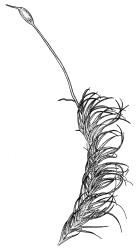- = Pseudoblindia Fedosov, M.Stech & Ignatov, Bot. J. Linn. Soc. 195: 561 (2020) nom. illeg.
- = Dicranum sect. Falcata Bruch & Schimp., Bryol. Eur. 1, 117 (1847)
Plants lustrous or dull, forming tufts or turves. Stems not or sparsely forked, in cross-section with a central strand, thin-walled medullary cells, and firm-walled cortical cells. Leaves lanceolate, tubulose, secund or erect-spreading, contorted or not when dry; mid laminal cells elongate, rectangular or ± quadrate, firm-walled, smooth (in N.Z. species) or ± mammillate; cells of leaf base more regular and elongate, often ± prorate, sometimes porose; alar cells usually well differentiated. Costa narrow, mostly filling the upper part of the leaf and appearing excurrent, in cross-section with stereids and guide cells either lacking (in N.Z. species) or weakly differentiated. Tubers absent.
Autoicous or polygamous. Perichaetial leaves sheathing. Perigonia terminal on short or elongate innovative branches arising below the perichaetia, or sessile below the perichaetia. Setae elongate and erect, dextrorse in upper portion; capsules nearly erect or inclined, smooth (in N.Z. species) or weakly furrowed, strumose or not, constricted below the ± transverse mouth when dry; stomata few and restricted to extreme capsule base; annulus well differentiated, compound, and revoluble; operculum rostrate, curved. Peristome teeth inserted at or below the mouth, deeply divided, pigmented at base or throughout, striolate or striate either at base or throughout. Calyptra cucullate, smooth, not fringed at base.
Kiaeria is closely allied to Dicranum but differs from it by its lack of costal stereid bands and by its autoicous sexuality, with perigonia that are terminal on innovative branches. The capsules are erect or somewhat curved and have deeply divided, typically dicranoid peristome teeth. Kiaeria is a small genus of about six species, with four species having an arctic-alpine distribution in the northern hemisphere. A type species has apparently not been designated. As recognised here it is bipolar.
| 1 | Plants lustrous, on rock; leaves strongly falcate-secund and not contorted when dry, mostly 2.8–3.2 mm; mid laminal cells elongate; spores 15–19 µm; common and widespread on rock | K. pumila |
| 1' | Plants dull, corticolous; leaves loosely secund and slightly contorted when dry, 2–2.7 mm; mid laminal cells shorter, mostly oblong or subquadrate, sometimes short-rectangular; spores 21–24 µm; rarely collected and epiphytic | K. spenceri |
| Category | Number |
|---|---|
| Indigenous (Endemic) | 1 |
| Indigenous (Non-endemic) | 1 |
| Total | 2 |




